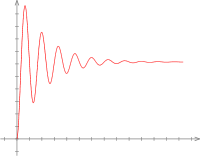- Joined
- Oct 9, 2012
- Location
- Earth!!!
- Thread Starter
- #21
Hello swampdonkey
"CPU Voltage Frequency" adjusts the pulse-width modulation (PWM) switching frequency of the motherboard's voltage regulator module (VRM) connected to the CPU vcore.
This setting can usually be left on auto, but I find 400-450 KHz works well on ASUS boards.
In a nutshell, the goal of PWM switching frequency is so reduce unmeasureable voltage change in voltage when a load is supplied to the VRM.
Similar to:

Generally, higher switching frequencies will dampen this response of the circuit, but at the expense of lower power efficiency and more VRM heat.
However one large reason the option is there, to dampen transient overshoot (a split second rise in voltage before returning to normal, it is the peak of the graph) and ringing (the waves) when Load-Line Calibration is in use.
This is unmeasurable and really should not make a difference in reliability or overclocks in normal cases so it is best left 400-450 KHz. The only real people that take advantage of this VRM tweaking feature would be those extreme overclockers using exotic cooling methods, extreme LLC and dangerous voltages.
So...
No need to worry.
Oh.
I've noted up to 0.04v gain under load with CPU-NB on Crosshair V Formula with LLC just at Regular (lowest), so if ASUS provides CPU-NB Voltage monitoring within AI Suite II I would take a look at it and maybe adjust accordingly. If it is anything like the Crosshair board, CPU-NB LLC is not needed.
As far as CPU Current Capability and CPU-NB Current Capability, these are simply Over-Current Protection adjustments. If you aren't throttling (CPU is not downclocking to low clocks), or shutting down at random when under intensive CPU load, then these can be left alone, these options cater to extreme overclockers as well.
Hope that helps!
-BeepBeep
Wow lol. I have searched for at least a month for all that info lol but no one has been able to provide an answer... until now!!!! lol cool thanks for all the info.
